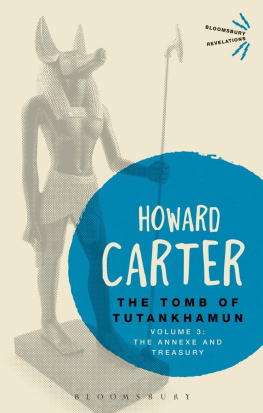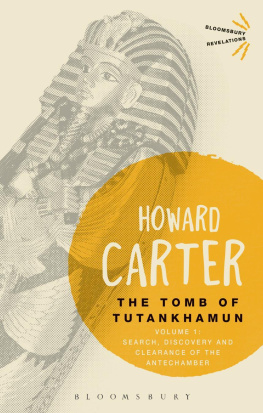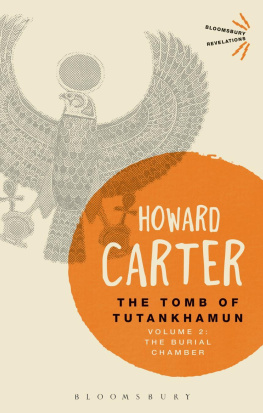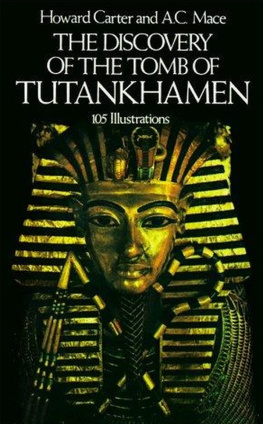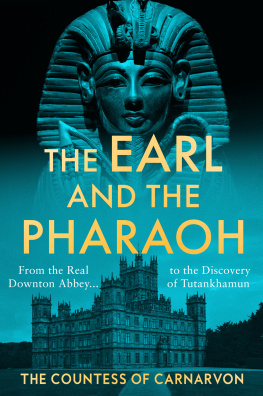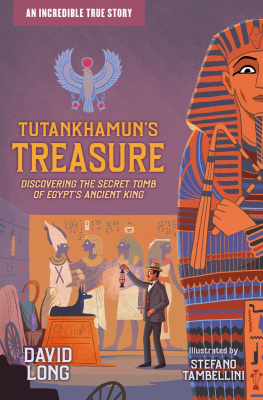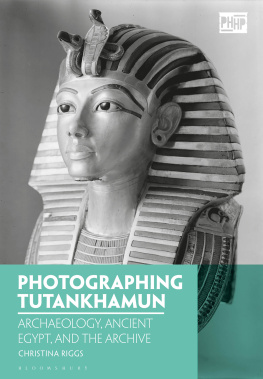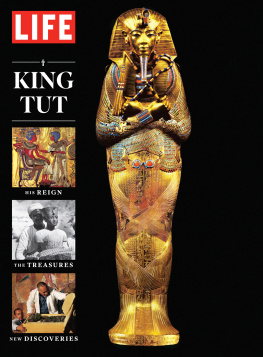The Tomb of Tutankhamun: Volume 3
TITLES IN THE BLOOMSBURY REVELATIONS SERIES
Aesthetic Theory , Theodor W. Adorno
The Oresteia , Aeschylus
Being and Event , Alain Badiou
Infinite Thought, Alain Badiou
On Religion, Karl Barth
The Language of Fashion , Roland Barthes
The Intelligence of Evil , Jean Baudrillard
Key Writings , Henri Bergson
I and Thou , Martin Buber
The Tomb of Tutankhamun: Volume 1 , Howard Carter and A. C. Mace
The Tomb of Tutankhamun: Volume 2 , Howard Carter
In Defence of Politics , Bernard Crick
Intensive Science and Virtual Philosophy , Manuel DeLanda
Cinema I , Gilles Deleuze
Cinema II , Gilles Deleuze
Difference and Repetition , Gilles Deleuze
A Thousand Plateaus , Gilles Deleuze and Flix Guattari
Anti-Oedipus , Gilles Deleuze and Flix Guattari
Origins of Analytical Philosophy , Michael Dummett
Taking Rights Seriously , Ronald Dworkin
Discourse on Free Will , Desiderius Erasmus and Martin Luther
The Theatre of the Absurd , Martin Esslin
Education for Critical Consciousness , Paulo Freire
Pedagogy of Hope , Paulo Freire
Marxs Concept of Man , Erich Fromm and Karl Marx
To Have or To Be? , Erich Fromm
Truth and Method , Hans Georg Gadamer
All Men Are Brothers , Mohandas K. Gandhi
Violence and the Sacred , Ren Girard
Among the Dead Cities , A. C. Grayling
Towards the Light , A. C. Grayling
The Three Ecologies , Flix Guattari
The Essence of Truth , Martin Heidegger
The Odyssey , Homer
Eclipse of Reason , Max Horkheimer
Language of the Third Reich , Victor Klemperer
Rhythmanalysis , Henri Lefebvre
After Virtue , Alasdair MacIntyre
Time for Revolution, Antonio Negri
Apologia Pro Vita Sua, John Henry Newman
The Politics of Aesthetics , Jacques Rancire
Course in General Linguistics , Ferdinand de Saussure
An Actor Prepares , Constantin Stanislavski
Building A Character , Constantin Stanislavski
Creating A Role , Constantin Stanislavski
Interrogating the Real , Slavoj iek
The Universal Exception, Slavoj iek
Some titles are not available in North America.

A CARVED IVORY PANEL
The scene represents TutankhAmen and his Queen AnkhesenAmen in a pavilion. From a lid of a box.
(See p. 118)
The Tomb of Tutankhamun: Volume 3
The Annexe and Treasury
Discovered by the late Earl of Carnarvon and Howard Carter
By Howard Carter

Bloomsbury Academic
An imprint of Bloomsbury Publishing Plc
| 50 Bedford Square | 1385 Broadway |
| London | New York |
| WC1B 3DP | NY 10018 |
| UK | USA |
www.bloomsbury.com
Bloomsbury is a registered trade mark of Bloomsbury Publishing Plc
First published in 1923, by Cassell & Company Ltd. Reprinted in 2003 by permission of The Griffith Institute, Oxford.
1923, 2014 Howard Carter.
Foreword 2003, 2014 Nicholas Reeves
Illustrations from Photographs by Harry Burton.
Publishers Note
The publishers wish to record their thanks to the French Ministry of Culture for a grant towards the cost of translation.
All rights reserved. No part of this publication may be reproduced or transmitted in any form or by any means, electronic or mechanical, including photocopying, recording, or any information storage or retrieval system, without prior permission in writing from the publishers.
No responsibility for loss caused to any individual or organization acting on or refraining from action as a result of the material in this publication can be accepted by Bloomsbury or the author.
British Library Cataloguing-in-Publication Data
A catalogue record for this book is available from the British Library.
ePub ISBN: 978-1-47257-778-8
Library of Congress Cataloging-in-Publication Data
A catalogue record for this book is available from the Library of Congress.
Typeset by Deanta Global Publishing Services, Chennai, India
At first I could see nothing, the hot air escaping from the chamber causing the candle flame to flicker, but presently, as my eyes grew accustomed to the light, details of the room within emerged slowly from the mist, strange animals, statues, and gold everywhere the glint of gold. For the moment an eternity it must have seemed to the others standing by I was struck dumb with amazement, and when Lord Carnarvon, unable to stand the suspense any longer, inquired anxiously, Can you see anything? it was all I could do to get out the words, Yes, wonderful things
(Howard Carter and Arthur C. Mace, The Tomb of TutankhAmen. Search, Discovery and the Clearance of the Antechamber, pp. 823)
On 4 November, 1922, Howard Carter and his sponsor, the fifth Earl of Carnarvon, made a discovery in Egypts Valley of the Kings which would change the face of archaeology for good. For the first time in recorded history, diggers had stumbled upon the virtually intact burial of an Egyptian pharaoh the boy-king Tutankhamun, son and successor of the heretic Akhenaten; and it was a tomb piled high with funerary treasures and gold. The popular perception of Egyptology changed overnight: no longer the worthy pursuit of dusty academics, it was now seen as high-stakes adventure. Without the excitement engendered by Tutankhamun, it is doubtful that Indiana Jones would ever have been born.
The story of the find reads like a fairytale fiction: how Carter dug for years with little success in pursuit of the impossible dream; how, in his final season, the tomb he sought was found; how this tomb impacted upon the world, turning its discoverers into celebrities overnight; and how, with the unexpected death of Lord Carnarvon (supposed victim of the pharaohs curse), the triumph turned sour.
The careful documentation and clearance of Tutankhamuns tomb, and the transportation to Cairo of the objects interred there, took Howard Carter the best part of a decade, with the excavators personal narrative of the work appearing in three wonderfully written, self-contained volumes published between 1923 and 1933. This, the third in the trilogy, describes the excavation of two of the store chambers the Treasury and the Annexe within which had been gathered many of the boy-kings most precious funerary treasures. Published in a relatively small edition in 1933, the book soon went out of print and has for many years been virtually unobtainable.
For all his riches, Tutankhamun was in life a relatively insignificant king, too young to impose his personality on the state he ruled and intentionally forgotten by those who came after. With the discovery of his tomb, his name was at long last made to live: today, more than three thousand years after his death, Egypts boy-king stands as a veritable icon not only of Egyptology itself, but of archaeological endeavour as a whole.
London, January 2000 | Nicholas Reeves |
Contents
The very stillness of its atmosphere, intensified by the many inanimate things that fill it, standing for centuries and centuries as pious hands had placed them, creates the sense of sacred obligation which is indescribable and which causes one to ponder before daring to enter, much less touch anything. E`motions thus aroused, of which the sense of awe is the root, are difficult to convey in words; the spirit of curiosity is checked; the very tread of ones foot, the slightest noise, tends to increase a fear and magnify an unconscious reverencethe intruder becomes mute.
Next page
